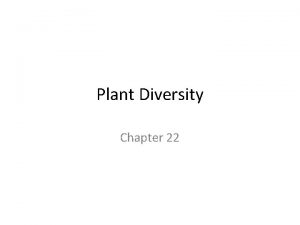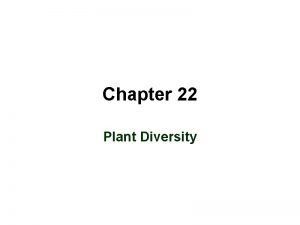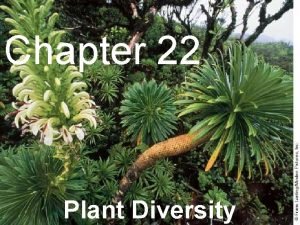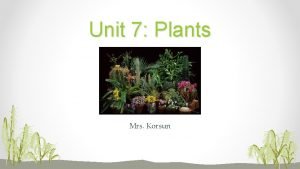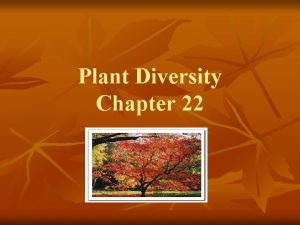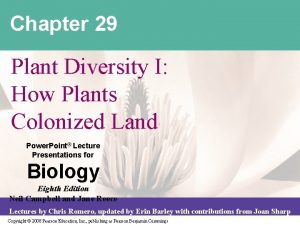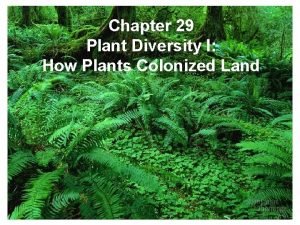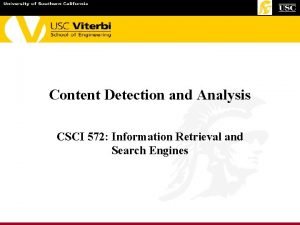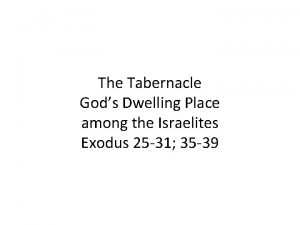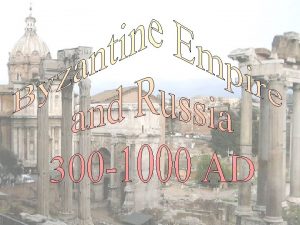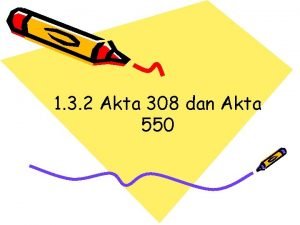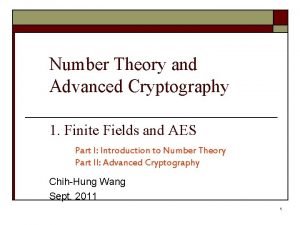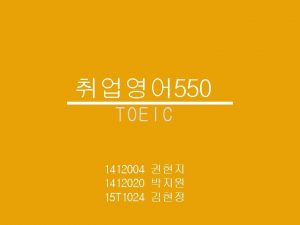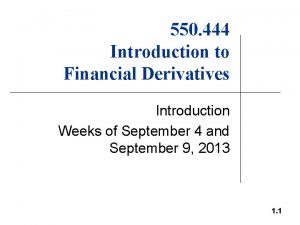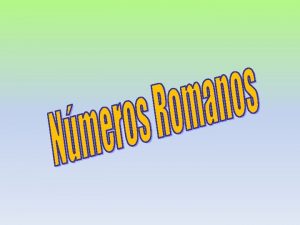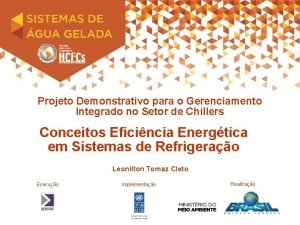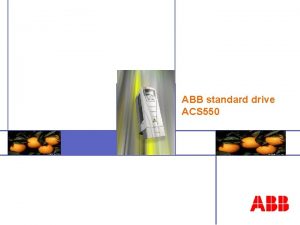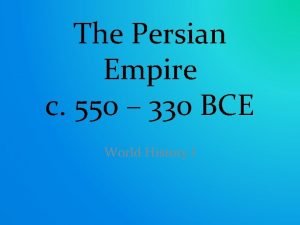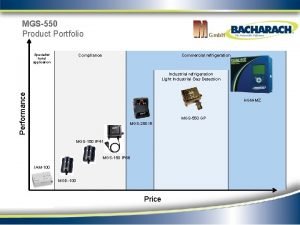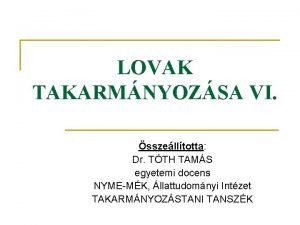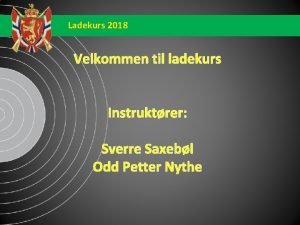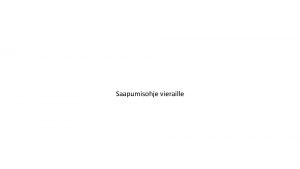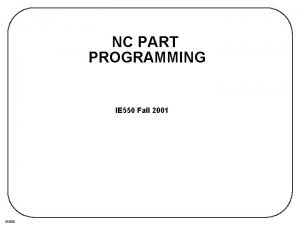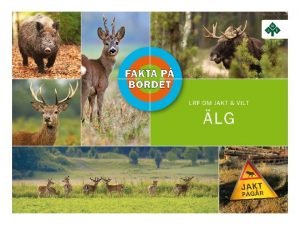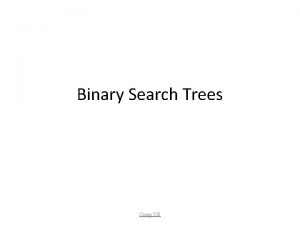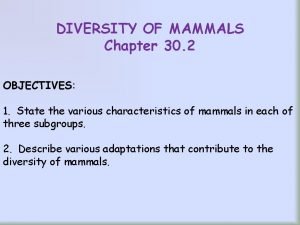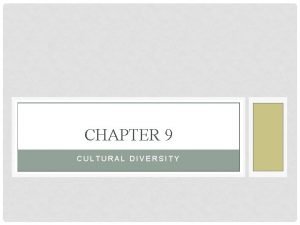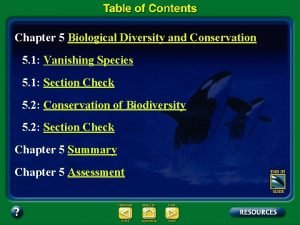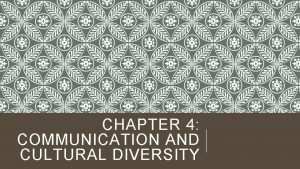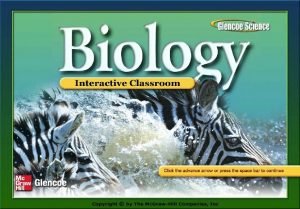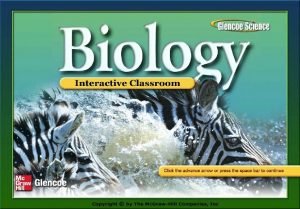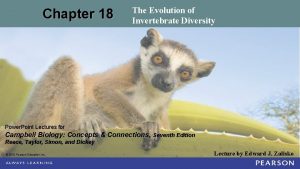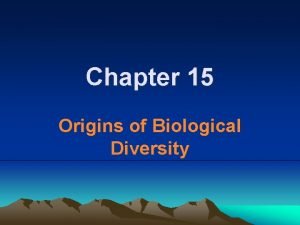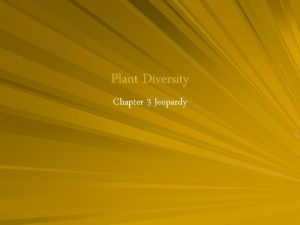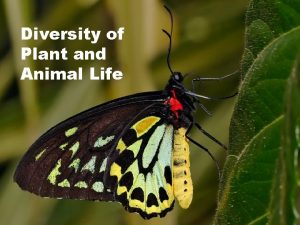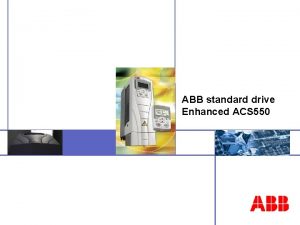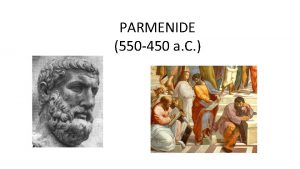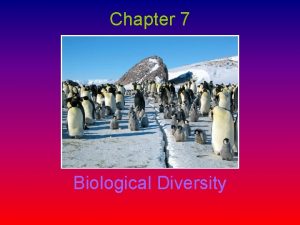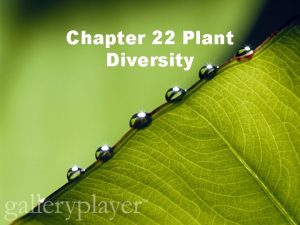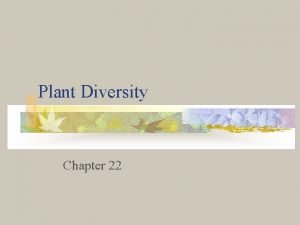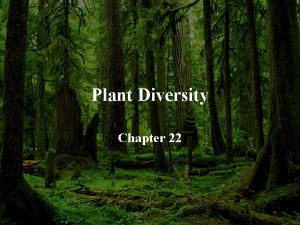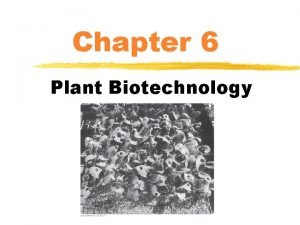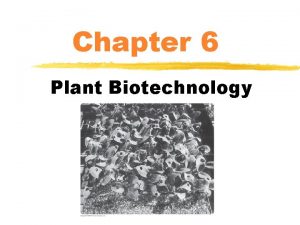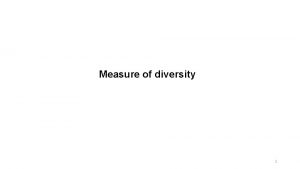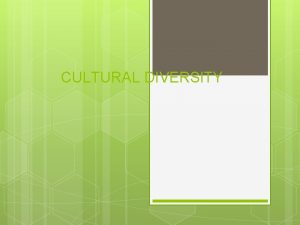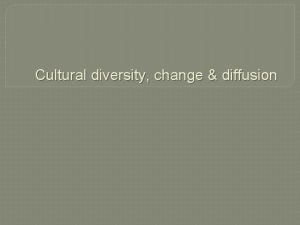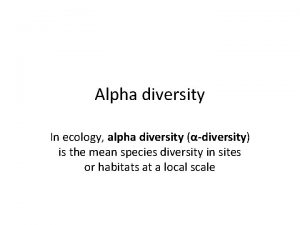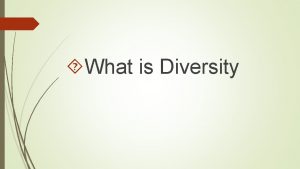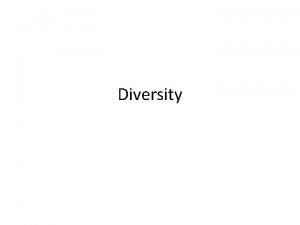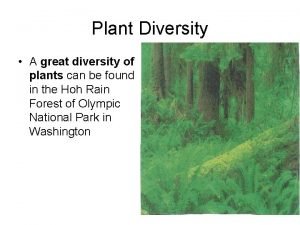Plant Diversity Ch 22 pg 550 572 Chapter


























































- Slides: 58

Plant Diversity Ch 22, pg 550 - 572

Chapter Overview • On to another kingdom! • Plants are familiar, but also far more complex than you think: – Inter-plant chemical warfare – Unusual plant-animal relationships – Surprising plant-weather relationships – Needed for economic and bodily well-being

• Newest Theory on the Table!!! • Genetic analysis points to the common ancestor of all plants. – extinct green algae species in class Charophyceae – modern charophyceans common in lakes and ponds

• Figure 1. 2 Evolution of Plants

Today’s Learning Objectives 1) Know the terms in this chapter. 2) What characteristics do all plants share? 3) List 2 benefits and 2 challenges for algae evolving into land plants. 4) What is alternation of generations? 5) List the four groups of plants.

Intro To Plants (22 -1) • Plants share the following characteristics: – Multicellular – Eukaryotic – Cell walls made of cellulose – Multicellular embryos – Photosynthesis with chlorophyll

Intro To Plants • Importance of plants – Basis of land-based food chains – Provide oxygen, shade, & shelter • First plants – 470 million years ago – Imagine world before plants… • For algae to evolve into plants, they had to get out of the water

Intro to Plants • Benefits of • Challenges moving to land adapting to land – Lots of sunlight – Plenty of CO 2 – Little competition – No herbivores –Harmful solar rays –Harder to get water to all cells –Sperm can’t swim in air –All cells cannot absorb nutrients from environment

Plant Overview Adapting to land 1. Preventing water loss • • • Cells need water to survive Evaporation a problem on land Stomata: allows air in & out Adaptation: • Cuticle – waxy protective covering that prevents water loss

Plant Overview 2. Reproduction w/o drying out • • In oceans can just let the sperm (and sometimes the eggs too) loose in the water On land, sperm cannot survive the air Adaptations: • • • Pollen Spore Seed

Plant Overview 3. Transporting materials • • • In ocean cells can just absorb water and minerals from environment On land, cannot absorb most nutrients from air, need to absorb from soil, need transport to & from roots, stem, and leaves Also lignin – allows upright growth Adaptation: • Vascular tissue – a type of tissue that transports water and nutrients

• 4. Plants have adaptations that prevent animals from eating them. – spines and thorns – defensive chemicals

Intro to Plants • Plant Life Cycle –Alternation of Generations – plants have two forms during their lives – one diploid and one haploid

Intro to Plants – Sporophyte – the spore producing form of a plant • Diploid (two copies of every chromosome) – Gametophyte – the gamete producing form of a plant • Haploid (one copy of every chromosome) – Alternation of Generations animation

Intro To Plants Four groups of plants 1. Non-vascular plants • Mosses & their relatives 2. Vascular, seedless plants • Ferns & their relatives 3. Naked-seed plants • Conifers 4. Flowering plants • The vast majority of plants

What is thing called?

Today’s Learning Objectives 1) Know the 3 groups of bryophytes and how being nonvascular affects their height and reproduction. 2) Know the 3 groups of seedless vascular plants and their key adaptations.

Bryophytes (22 -2) • Bryophytes – grouping of mosses and related simple plants – They have no specialized tissue to transport water, minerals, or food from one part of the plant to another » https: //app. discoveryedu cation. com/learn/videos/3 74 E 21 F 6 -8628 -411 A-89 C 1 4933 C 87 DC 8 A 1? has. Local Host=false!

Bryophytes – Very small because • Have no tissues to transport water to upper part of plant or food to lower part of plant • Use osmosis & diffusion only – Live only in areas that are very wet part of the year because: • Release sperm that must swim to eggs of the same species • Also helps to be small for this reason

Bryophytes • Three groups of bryophytes 1. Mosses 2. Liverworts 3. Hornworts

Bryophytes • Mosses – the most common bryophytes (peat moss) – Only a few cm tall – Can live in very poor (or no) soil – Tolerate very low temps (can go dormant during winter) – Often see on rocks near a river or in woody areas on the ground

Bryophytes • Moss structure: – Rhizoid instead of root • Simpler, no transport tissue – Green parts • False stem • False leaves – Brown parts • Stalk • Capsule

Bryophytes • Liverworts – Less common – Look like flat leaf on ground with funny umbrella-like structure sticking up • Sexual reproduction via umbrellas • Asexual reproduction via cups called gemmae

Bryophytes • Hornworts – Even less common – Like a liverwort, but instead of umbrella-like structures, have thread -like green horns

Bryophytes • Life Cycle of Bryophytes – Unlike rest of plants, here the gametophyte stage is larger than the sporophyte stage • Green parts = gametophyte – Make egg & sperm at tips – Sperm swim out in rain and swim up to eggs on next moss • Brown parts = sporophyte – Grow right out of the top of the gametophyte – Parasitic on the gametophyte stage – Releases spores from higher up (spread farther) – Spores grow into new gametophytes

Life Cycle of Bryophytes

Seedless Vascular Plants (22 -3) • Advantage of seedless vascular plants: – Vascular tissue – groups of specialized cells that transport water & nutrients • 2 kinds of vascular tissue 1. Xylem 2. Phloem

Seedless Vascular Plants – Xylem • Transports water • Cells are like thick, empty straws • A path for water to move relatively quickly • Water moves upwards from roots…how? – Partly capillary pressure – Partly pulled upwards by transpiration » Transpiration – evaporation of water from leaves of plants

Seedless Vascular Plants – Phloem • Transports “food” (sugars, etc. ) • Cells may be reinforced with lignin – Lignin – strong, rigid substance that makes cell walls even stronger (woody)

Seedless Vascular Plants • Other evolutionary adaptations – Roots – underground organs that absorb water & minerals • Unlike rhizoids, these have specific tissues to transport water – Leaves – organs for photosynthesis with vascular tissue – Stems – supporting structures that connect leaves & roots with vascular tissue

Seedless Vascular Plants • 3 groups of seedless vascular plants 1. Club mosses 2. Horsetails 3. Ferns – https: //www. youtube. com/watch? v=VKSsmv 1 g 7 A

Seedless Vascular Plants • Club mosses – Ancient group – Used to grow in great forests, now only a few smaller varieties live – Called “ground pines”

Seedless Vascular Plants • Horsetails – Only living member of this ancient group – Also used to grow as huge trees – Are about 12 inches tall here – Grow in sandy soil – Have unusual characteristic • Silica in cells (like sand) • AKA: scouring rush – used for cleaning pans • AKA: puzzle grass – you can take it apart and put it back together!

Horsetails • Wanted: Cash Reward! – I’ll pay $5 for the first two horsetails I receive (that are in good shape)

Seedless Vascular Plants • Ferns – Fairly common shade plant – Rhizomes – underground stem – Fronds – the leaves of a fern

Seedless Vascular Plants • Life Cycle of Ferns – The sporophyte is the dominant (larger) form • Look on underside of fronds, often see groups of dark round spores – Gametophyte is tiny, separate liverwort-like plant • Forms egg and sperm on bottom of the gametophyte


Today’s Learning Objectives 1) How do the adaptations of seed plants make them successful? 2) What are gymnosperms and angiosperms?

Seed Plants (22 -4) • Advantages of the seed plants – They can reproduce sexually without water – Specific adaptations of seed plants • Cones & flowers • Pollen & pollination • Seeds

Seed Plants – Cones & flowers – carry seeds, may attract pollinators – Pollen grain – tiny male gametophyte • Can be spread by wind or animal • When reaches female gametophyte of same species, it produces sperm there, eliminating need for water • I. e. the sperm doesn’t swim to egg, it is delivered

Seed Plants – Seed – a plant embryo surrounded by a food supply, and encased in a protective covering • Plant embryo stays dormant until seed is in ideal, moist environment (sometimes for years)

Seed Plants • 2 groups of seed plants 1. Gymnosperms – naked seed plants – “naked seeds” – seeds that are not enclosed in a fruit – Seeds are held in a cone until mature, then they drop 2. Angiosperms – covered seed plants (flowering plants) – We’ll come back to these later

Gymnosperms • 4 groups of gymnosperms 1. 2. 3. 4. Gnetophytes Cycads Ginkgoes Conifers

Gymnosperms • Gnetophytes – small group, uncommon

Gymnosperms • Cycads – fern-like trees, but with cones

Gymnosperms • Ginkgoes – only one species left – Ginkgo biloba – “living fossil, ” from China, but grown worldwide, especially in cities – Looks like deciduous tree, but with unique, beautiful leaves – Ginkgo extract is taken as a memory enhancer • Although scientific studies don’t demonstrate that it helps you remember

Gymnosperms • Conifers – cone-bearing trees & shrubs that are often green yearround – Ex. pine trees, spruces, firs, cedars, sequoias, redwoods, junipers, yews, & larches – Have male cones that release pollen via wind – Have sticky female cones that catch pollen, then hold seeds for over a year

Gymnosperms – Needles – specialized leaves that lose very little water via transpiration • Low surface area • Thick waxy coat • Holes for gas exchange hidden in grooves • Film https: //app. discoveryeducation. com/learn/videos/659 F AE 2 D-5 A 1 F-4 CCD-94 FCC 543683706 F 6? has. Local. Host=false

Today’s Learning Objectives 1) What are gymnosperms and angiosperms? 2) Contrast monocots from dicots.

Angiosperms (22 -5) • Angiosperms are flowering plants – Evolved at least 135 million years ago – Took over land areas from other plants – By far the dominant form of plant life today – Examples: Oaks, maples, most bushes, grasses (including corn, wheat, etc. ), most crop plants, tulips, roses, wildflowers, etc.

Angiosperms • Advantages of the angiosperms – Flowers – attract pollinators to deliver pollen • Much more efficient than relying on wind or water (although many still use wind) • Pollinators visit the same type of flower in sequence – Fruit – ovary tissue that surrounds a seed • Sometimes edible to attract animals to spread the seed • Sometimes provides other means of transportation – Such as flight! • Anything with seeds inside is a fruit – Grow more quickly than gymnosperms

• A stamen is the male structure of the flower. stamen filament anther – anther produces pollen grains – filament supports the anther

• The innermost layer of a flower is the female carpel. stigma carpel style ovary – stigma is sticky tip – style is tube leading from stigma to ovary – ovary produces female gametophyte

Angiosperms • Two main groups of angiosperms 1. Monocots 2. Dicots – Based on several characteristics

Diversity of Angiosperms

Diversity of Angiosperms

Angiosperms • Other ways to categorize angiosperms – Woody vs. herbaceous • Woody plants have harder, nonphotosynthetic stems (trees, bushes, vines) • Herbaceous plants have green stems that aren’t as hard (ex. dandelions, sunflowers, peonies)

Angiosperms • Annuals, biennials, & perennials – Annuals – grow, reproduce, & die in 1 year • Ex. Crops such as wheat & corn, many garden flowers – Biennials – grow in the first year, reproduce and die in the second year • Ex. celery – Perennials – grow many years, often reproduce every year • Ex. Grasses, trees, also many garden flowers
 Chapter 22 plant diversity
Chapter 22 plant diversity Biology chapter 22 plant diversity answer key
Biology chapter 22 plant diversity answer key Chapter 22 plant diversity answer key
Chapter 22 plant diversity answer key Chapter 20 plant diversity
Chapter 20 plant diversity Plant diversity chapter
Plant diversity chapter Charophytes characteristics
Charophytes characteristics Microphyll vs megaphyll
Microphyll vs megaphyll 572 merupakan unsur akor dari
572 merupakan unsur akor dari Cse 572
Cse 572 Csci 572
Csci 572 Ese 572
Ese 572 Data mining
Data mining Find the odd one : 396, 462, 572, 427, 671, 264
Find the odd one : 396, 462, 572, 427, 671, 264 Genetic diversity and biodiversity
Genetic diversity and biodiversity Ecosystem jigsaw activity
Ecosystem jigsaw activity 603 550 israelites
603 550 israelites Byzantine empire 550 ad
Byzantine empire 550 ad 550 poirier st coquitlam bc
550 poirier st coquitlam bc Surat seksyen 308(2)
Surat seksyen 308(2) Dcs 550
Dcs 550 Inverse of 550 in gf(1759)
Inverse of 550 in gf(1759) 550 en yakın yüzlüğe yuvarlayınız
550 en yakın yüzlüğe yuvarlayınız Toeic 550
Toeic 550 550-444
550-444 624 en numeros romanos
624 en numeros romanos Unc comp 550
Unc comp 550 Ach 550
Ach 550 5+5+5=550
5+5+5=550 Ahri
Ahri Gupta sculpture
Gupta sculpture 550
550 550+330
550+330 Telit sat 550
Telit sat 550 Mgs-550
Mgs-550 Ie 550
Ie 550 Tth 550
Tth 550 Billig hylsetrommel
Billig hylsetrommel Itäkeskus liityntäpysäköinti
Itäkeskus liityntäpysäköinti Fibrinogeno 550
Fibrinogeno 550 Ie 550
Ie 550 200 550
200 550 Binary search recursive algorithm
Binary search recursive algorithm Intraspecific hybridization
Intraspecific hybridization Taichum
Taichum Plant introduction in plant breeding
Plant introduction in plant breeding Tronsmo plant pathology and plant diseases download
Tronsmo plant pathology and plant diseases download Tronsmo plant pathology and plant diseases download
Tronsmo plant pathology and plant diseases download Albugo eye
Albugo eye Chapter 30 section 2 diversity of mammals
Chapter 30 section 2 diversity of mammals Chapter 9 cultural competence
Chapter 9 cultural competence Chapter 8 human resources culture and diversity
Chapter 8 human resources culture and diversity Chapter 8 test human resources culture and diversity
Chapter 8 test human resources culture and diversity Diversity and human needs and development
Diversity and human needs and development Biological diversity and conservation chapter 5 answers
Biological diversity and conservation chapter 5 answers Chapter 4 communication and cultural diversity
Chapter 4 communication and cultural diversity Chapter 30 section 1 mammalian characteristics
Chapter 30 section 1 mammalian characteristics Chapter 26 section 3 insects and their relatives
Chapter 26 section 3 insects and their relatives Chapter 18 the evolution of invertebrate diversity
Chapter 18 the evolution of invertebrate diversity Chapter 15 origins of biological diversity answers
Chapter 15 origins of biological diversity answers
